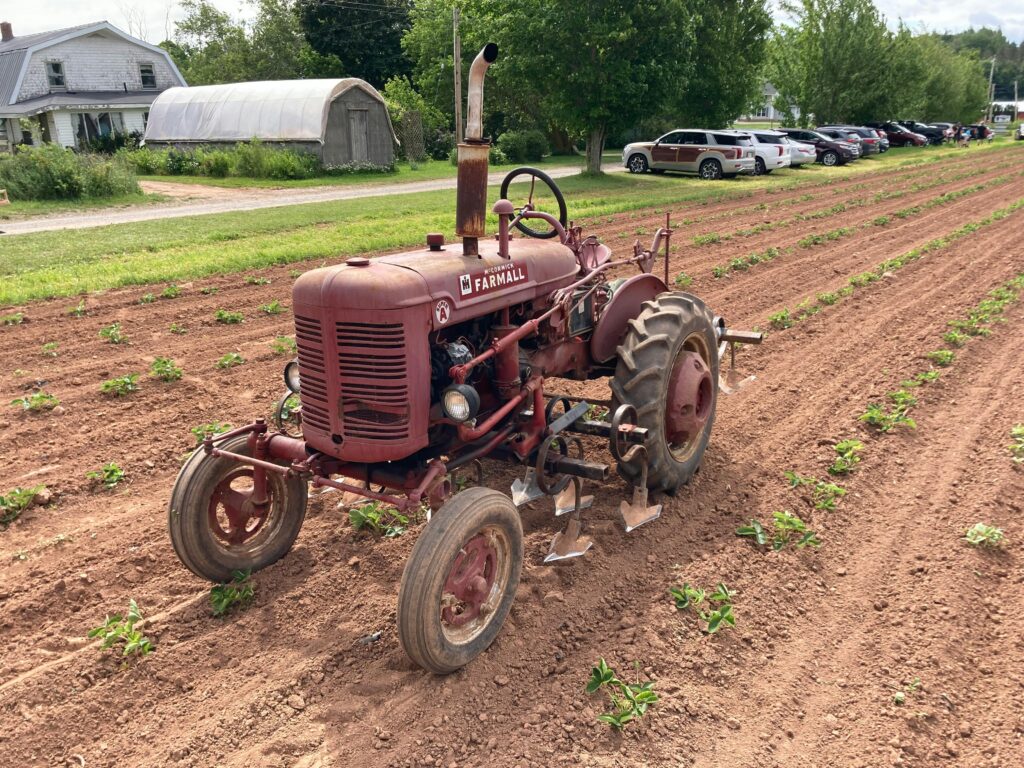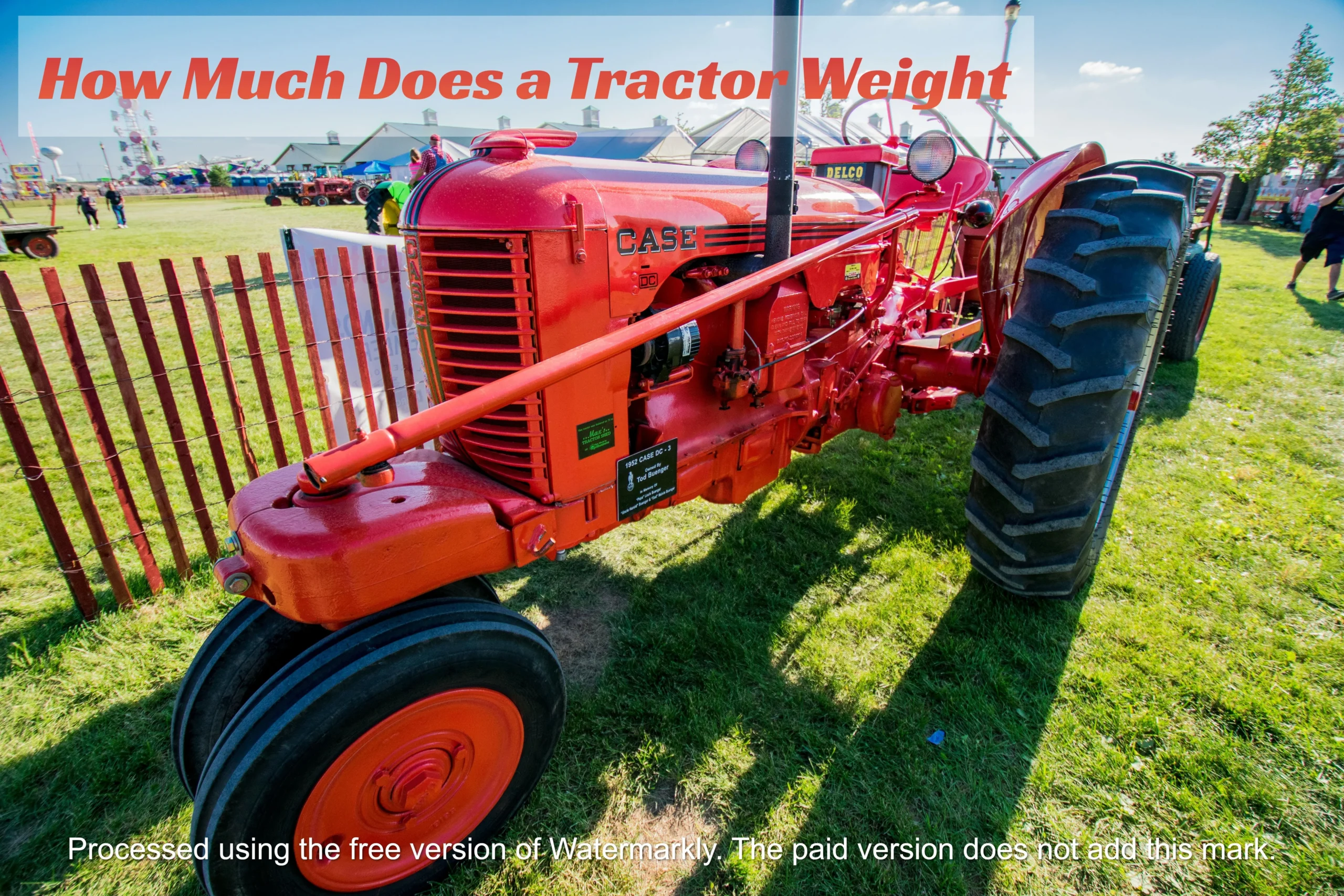The weight of a tractor varies depending on its size, make, and model. Generally, a compact utility tractor might weigh around 1,500 to 3,000 pounds, while larger agricultural tractors can range from 8,000 to 25,000 pounds or more. The weight of a tractor is crucial for its stability and performance, allowing it to effectively navigate different terrains and handle various tasks such as plowing, towing, and hauling.
Introduction
Tractors are powerful machines designed to perform various agricultural and construction tasks. Their weight is a crucial factor that determines their performance, stability, and suitability for specific applications. In this comprehensive article, we’ll delve into the world of tractor weights, exploring the factors that influence their mass, the different weight categories, and the implications of weight on tractor performance and operation.
Understanding Tractor Weight
Tractor weight is a multifaceted topic that encompasses several factors, including the tractor’s size, power, and intended use. Manufacturers carefully consider these elements when designing and engineering tractors to ensure optimal performance, safety, and efficiency.
Factors Influencing Tractor Weight
1. Size and Power
Generally, larger and more powerful tractors tend to weigh more than their smaller counterparts. This increased weight is necessary to provide the necessary traction, stability, and support for the heavy-duty tasks these machines are designed to perform.
2. Intended Use
Tractors are built for various applications, such as agriculture, construction, forestry, and landscaping. The intended use of the tractor significantly impacts its weight, as it determines the required power, attachments, and overall design.
3. Materials and Components
The materials used in the construction of the tractor, as well as the components and systems incorporated into its design, contribute to its overall weight. Manufacturers strive to strike a balance between weight and durability, ensuring the tractor can withstand the rigors of its intended use while maintaining optimal performance.

Weight Categories
Tractors can be broadly categorized based on their weight, which is often closely tied to their horsepower and intended use. Here are some common weight categories:
1. Compact Tractors
Compact tractors, also known as sub-compact or lawn and garden tractors, typically weigh between 500 and 2,000 pounds (225 to 900 kg). These lightweight machines are designed for smaller-scale operations, such as residential or small-scale agricultural tasks.
2. Utility Tractors
Utility tractors, sometimes referred to as mid-range tractors, usually weigh between 2,000 and 6,000 pounds (900 to 2,700 kg). These versatile machines are suitable for a wide range of agricultural and light construction tasks.
3. Row-Crop Tractors
Row-crop tractors, designed specifically for row-crop farming, typically weigh between 10,000 and 18,000 pounds (4,500 to 8,100 kg). Their weight and design allow them to navigate between crop rows while providing sufficient power and traction for tasks such as plowing, planting, and harvesting.
4. Agricultural Tractors
Agricultural tractors, also known as farm tractors, are heavy-duty machines designed for large-scale farming operations. Their weight can range from 18,000 to 30,000 pounds (8,100 to 13,600 kg), depending on their horsepower and intended use.
5. Industrial Tractors
Industrial tractors, commonly used in construction, mining, and forestry applications, are among the heaviest tractors available. Their weight can exceed 30,000 pounds (13,600 kg), with some models weighing over 50,000 pounds (22,700 kg). This immense weight is necessary to provide the traction and stability required for heavy-duty tasks, such as moving large loads or operating heavy attachments.
Importance of Tractor Weight
The weight of a tractor plays a crucial role in its performance, efficiency, and safety. Here are some key considerations related to tractor weight:
1. Traction and Stability
Tractor weight directly affects the machine’s traction and stability. Heavier tractors have better grip and are less likely to slip or slide, especially when operating on slippery or uneven terrain. This increased traction and stability improve the tractor’s overall performance and safety.
2. Ballasting
Ballasting is the process of adding weight to a tractor to improve its traction and stability. This can be achieved by adding weight boxes, liquid ballast (such as calcium chloride solution) to the tractor’s tires, or attaching additional weights to the front or rear of the machine. Proper ballasting is essential for optimizing the tractor’s performance and preventing accidents caused by insufficient traction or stability.
3. Implement Compatibility
The weight of a tractor also determines the types of implements and attachments it can effectively operate. Heavier tractors are better suited for pulling or operating larger, more demanding implements, such as heavy-duty plows, planters, or harvesters. Conversely, lighter tractors are more suitable for smaller implements and tasks that require greater maneuverability.
4. Fuel Efficiency
While heavier tractors generally offer better traction and stability, they may also consume more fuel due to the increased weight and power required to move them. Manufacturers strive to strike a balance between weight and fuel efficiency, incorporating advanced technologies and lightweight materials to optimize performance without compromising fuel economy.
5. Soil Compaction
The weight of a tractor can contribute to soil compaction, a phenomenon where the soil becomes compressed and loses its ability to retain air and water. Excessive soil compaction can negatively impact crop growth and yield. To mitigate this issue, manufacturers design tractors with larger tires or track systems to distribute the weight over a larger surface area, reducing the pressure exerted on the soil.

Determining Tractor Weight
Determining the exact weight of a tractor can be achieved through various methods, including:
1. Manufacturer Specifications
Tractor manufacturers provide detailed specifications, including the weight of the machine, in their product literature and manuals. These specifications are typically based on the tractor’s base configuration, without additional implements or attachments.
2. Weighing Scales
Specialized weighing scales or truck scales can be used to accurately measure the weight of a tractor. This method is particularly useful when the tractor is equipped with additional components or attachments, as it provides the total weight of the complete unit.
3. Calculation Methods
In some cases, the weight of a tractor can be estimated using calculation methods based on its dimensions, materials, and components. However, these methods may not be as accurate as directly weighing the machine or consulting manufacturer specifications.

Tractor Weight and Performance
The weight of a tractor has a direct impact on its performance in various aspects, including:
1. Drawbar Pull
Drawbar pull is the force a tractor can exert to pull an implement or load. Heavier tractors generally have higher drawbar pull capabilities, allowing them to handle heavier loads and more demanding tasks.
2. Power-to-Weight Ratio
The power-to-weight ratio is a measure of a tractor’s ability to convert its engine power into usable force or traction. A higher power-to-weight ratio typically translates to better performance, especially in challenging terrain or when operating heavy implements.
3. Fuel Efficiency
As mentioned earlier, heavier tractors generally consume more fuel due to the increased power and energy required to move their greater mass. However, modern tractors incorporate advanced technologies and efficient engine designs to optimize fuel efficiency while maintaining the necessary weight for optimal performance.
4. Maneuverability
Tractor weight can also impact maneuverability, especially in tight spaces or on uneven terrain. Lighter tractors tend to be more maneuverable, while heavier models may require more skill and caution when navigating tight corners or slopes.
5. Implement Compatibility
The weight of a tractor determines the types of implements and attachments it can effectively operate. Heavier tractors are better suited for demanding tasks that require significant pulling power or lifting capacity, while lighter tractors are more suitable for smaller-scale operations or tasks that prioritize maneuverability over raw power.
Tractor Weight and Safety
Safety is of paramount importance when operating tractors, and weight plays a crucial role in ensuring a safe working environment. Here are some key considerations related to tractor weight and safety:
1. Stability and Rollover Prevention
Heavier tractors generally have a lower center of gravity, which improves their stability and reduces the risk of rollovers, especially when operating on slopes or uneven terrain. Additionally, the increased weight provides better traction, further enhancing stability and control.
2. Braking Performance
The weight of a tractor directly impacts its braking performance. Heavier tractors require more robust braking systems and longer stopping distances due to their greater momentum. Proper maintenance and adjustment of brakes are essential for ensuring safe and effective braking, regardless of the tractor’s weight.
3. Operator Safety
Tractor weight can also affect operator safety. Heavier tractors may require additional safety features, such as Roll-Over Protective Structures (ROPS) and seatbelts, to protect the operator in the event of a rollover or accident.
4. Load Capacity and Weight Distribution
Proper weight distribution is crucial for safe and efficient tractor operation. Overloading or improper weight distribution can lead to stability issues, reduced traction, and increased wear on the tractor’s components. Manufacturers provide specific load capacity and weight distribution guidelines to ensure safe operation.
5. Maintenance and Handling
Heavier tractors require more robust maintenance practices and specialized equipment for handling and transportation. Regular inspections, proper tire inflation, and adherence to manufacturer guidelines are essential to ensure the safe operation and longevity of these powerful machines.
Optimizing Tractor Weight
Manufacturers and operators alike strive to optimize tractor weight to achieve the best balance between performance, efficiency, and safety. Here are some strategies employed to optimize tractor weight:
1. Precision Manufacturing
Advances in manufacturing techniques and materials allow tractor manufacturers to optimize weight distribution and reduce unnecessary weight without compromising strength or durability. Precision manufacturing processes, such as advanced welding techniques and lightweight material selection, contribute to weight optimization.
2. Ballasting Systems
As mentioned earlier, ballasting systems allow operators to adjust the weight of their tractors to suit specific tasks or operating conditions. By adding or removing weight boxes or liquid ballast, operators can optimize traction, stability, and implement compatibility while minimizing unnecessary weight.
3. Tire and Track Selection
The choice of tires or track systems can significantly impact a tractor’s weight and performance. Larger tires or tracks distribute the weight over a greater surface area, reducing soil compaction and improving traction, while also contributing to the overall weight of the machine.
4. Implement and Attachment Selection
Careful selection of implements and attachments can help optimize the overall weight of the tractor-implement combination. Choosing lightweight yet durable implements and attachments can reduce the overall weight while maintaining the necessary performance and functionality.
5. Advanced Technologies
Manufacturers continuously develop and incorporate advanced technologies, such as precision agriculture systems, telematics, and autonomous features, to enhance tractor performance and efficiency. These technologies can help optimize weight distribution, reduce operator fatigue, and improve overall productivity.
Conclusion
Tractor weight is a critical factor that influences performance, efficiency, and safety in various agricultural and construction applications. Understanding the weight categories, the factors that influence weight, and the importance of proper weight distribution and ballasting is essential for safe and effective tractor operation.
Manufacturers continuously strive to optimize tractor weight through precision manufacturing, advanced materials, and innovative technologies, ensuring that these powerful machines meet the evolving demands of modern agriculture and construction industries.
By carefully considering tractor weight and its implications, operators can make informed decisions, maximize productivity, and prioritize safety in their daily operations. Whether you’re a seasoned farmer, a construction professional, or a hobbyist, understanding the intricacies of tractor weight will undoubtedly enhance your knowledge and contribute to the successful utilization of these versatile and indispensable machines.
FAQs
1. What is the average weight of a typical agricultural tractor?
The average weight of a typical agricultural tractor can range from 10,000 to 18,000 pounds (4,500 to 8,100 kg), depending on the tractor’s horsepower, intended use, and specific model.
2. How does tractor weight affect fuel efficiency?
Generally, heavier tractors tend to consume more fuel due to the increased power and energy required to move their greater mass. However, manufacturers strive to optimize fuel efficiency through advanced engine designs, lightweight materials, and precision engineering.
3. Can tractor weight be adjusted for specific tasks or conditions?
Yes, tractor weight can be adjusted through ballasting systems, which allow operators to add or remove weight boxes or liquid ballast to optimize traction, stability, and implement compatibility for specific tasks or operating conditions.
4. What is the importance of proper weight distribution in tractor operation?
Proper weight distribution is crucial for safe and efficient tractor operation. Improper weight distribution can lead to stability issues, reduced traction, and increased wear on the tractor’s components. Manufacturers provide specific guidelines for load capacity and weight distribution to ensure safe operation.
5. How does tractor weight affect soil compaction?
Heavier tractors can contribute to soil compaction, a phenomenon where the soil becomes compressed and loses its ability to retain air and water. To mitigate this issue, manufacturers design tractors with larger tires or track systems to distribute the weight over a larger surface area, reducing the pressure exerted on the soil.
